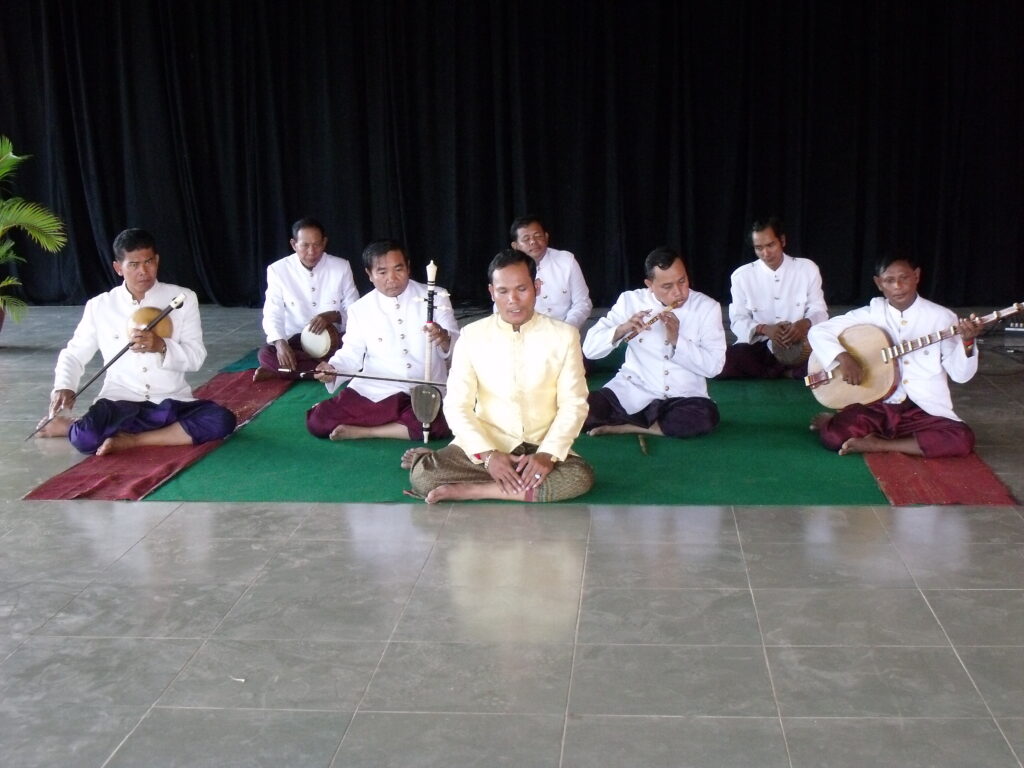ប្រពៃណីខ្មែរមានឫសគល់ជ្រៅ ប្រកបដោយលក្ខណៈសាមញ្ញនិងត្រូវបានទទួលយកច្រើនជាអ្វីៗថ្មី ពោលគឺនុវានុវត្តន៍ ដែលជាការណែនាំនូវអ្វីៗថ្មី ដូចជាគំនិត មធ្យោបាយ ឬសម្ភារៈ និងឧបករណ៍ថ្មី។ នៅពេលនិយាយអំពី “ប្រពៃណី” យើងនិយាយអំពីការអភិវឌ្ឍជាប្រព័ន្ធ គឺមានការរំពឹងទុក មានបទដ្ឋាន អ្វីមួយដែលអ្នកទស្សនាធ្លាប់បានយល់និងស្គាល់រួចមកហើយ។ ជាលទ្ធផលគេអាចរីករាយទស្សនាទស្សនីយភាពណាមួយ ឧទាហរណ៍ ការប្រគំតន្រ្តី។
សាកលវិទ្យាល័យភូមិន្ទវិចិត្រសិល្បៈ គឺជាស្ថាប័នតែមួយគត់នៅកម្ពុជាដែលផ្តល់នូវវគ្គសិក្សាផ្លូវការនិងវិជ្ជាជីវៈក្នុងផ្នែកសិល្បៈជាប្រព័ន្ធ។ អ្នកដែលបានបញ្ចប់ការសិក្សា ឬសិល្បករនិងសិល្បការិនី នៃសាកលវិទ្យាល័យ ត្រូវបានគេលើកកម្ពស់ចាត់ទុក និងគោរពជា “អ្នកជំនាញវិជ្ជាជីវៈអាជីព”។ នៅក្នុងន័យពេញលេញនៃពាក្យ “វិជ្ជាជីវៈអាជីព” សិល្បករសិល្បការិនីទាំងនេះ ទទួលបានតំណែង ឋានៈ និងការទទួលស្គាល់យ៉ាងត្រឹមត្រូវពីស្រទាប់មហាជន ក៏ដូចជាអ្នកជំនាញ។ ជាទូទៅ ល្បករសិល្បការិនីទាំងនេះ ធ្វើនវកមុ្ម ដោយប្រុងប្រយ័ត្នជាទីបំផុត។
នៅកម្ពុជា នុវានុវត្តន៍កើតឡើងជាពិសេសក្នុងចំណោមយុវជនបច្ចុប្បន្ន។ នេះគឺជាភាសា និងមធ្យោបាយនៃសម័យកាលសមស្របរបស់គេ។ នុវានុវត្តន៍ មិនមែនជាជម្រើសថ្មីមួយទៀតទេ ប៉ុន្តែគឺជាការរួមផ្សំបន្ថែមទៅលើប្រពៃណី។ កូនចៅជំនាន់ក្រោយរបស់យើងត្រូវទទួលបានការណែនាំ លើកទឹកចិត្ត ហើយពួកគេត្រូវតែទទួលបាននូវបទពិសោធន៍ តន្រ្តីទៅតាមសម័យកាលរបស់គេផងដែរ។ ម្យ៉ាងវិញទៀត វាអាចជាការខូចខាតនិងប៉ះពាល់ធំធេងណាស់ចំពោះការបាក់ទឹកចិត្ត ក៏ដូចជាការឃាត់ឃាំងរារាំងមិនុំឱ្យមាននវានុវត្តន៍។
នវានុវត្តន៍គឺសំដៅទៅលើគំនិត ការអនុវត្ត និងរបៀបរបប។ បើនិយាយពីកម្ពុជាវិញ សិល្បករខ្មែរពុំបានធ្វើនវកម្មច្រើនណាស់ណានោះទេ បើធៀបទៅនឹងពិភពលោកនិងអាស៊ី។ យើងគួរតែលើកទឹកចិត្តដល់សិល្បករខ្មែរ អ្នកជំនាញ ឬបុគ្គលដទៃទៀត ឱ្យធ្វើការងារប្រកបដោយភាពច្នៃប្រឌិតបន្ថែមទៀត។
ទំនោរថ្មីនៃតន្រ្តីបុរាណប្រពៃណីនៅកម្ពុជា ឧទាហរណ៍ តន្រ្តីអាពាហ៍ពិពាហ៍ ខ្មែរ គឺមានការបញ្ចូលបន្ថែមនូវឧបករណ៍តន្ត្រីហ្គីតារបាស់និងស្គរបស្ចឹមប្រទេស។ ជាអាទិ៍មាន៖
ផលិតកម្ម ឆ្លងដែន
ការរួមផ្សំ/លាយបញ្ចូលគ្នានៃឧបករណ៍តន្រ្តី
អង្គរហ្សាស់
ការប្រើប្រាស់ឧបករណ៍តន្រ្តីខ្មែរជាភ្លេងកំដរសម្រាប់ប្រភេទតន្ត្រីថ្មី ដូចជា រែប
ការធ្វើពិសោធន៍ជាមួយឧបករណ៍តន្រ្តីខ្មែរក្នុងចម្រៀងរែប
ប្រាជ្ញ លី
ការប្រើប្រាស់ឧបករណ៍តន្រ្តីបុរាណក្នុងចម្រៀងសម័យខ្មែរ
អង្គររាត្រី (Les Nuits d’Angkor)
អូតេឡូ (Othello)
រដូវកាលអន្តោប្រវេសន៍ (Seasons of Migration)ជាដើម។ល។
ចង្វាក់ គឺជាកត្តានិងធាតុសំខាន់ក្នុងចម្រៀងយុវវ័យខ្មែរនៃសតវត្សទី២១។ ស្ថានភាពមួយចំនួន គឺជាចម្លើយទៅនឹងសំណួរសួរថា តើអ្វីទៅជាភ្លេងនិងភាពពីរោះ (នៅក្នុងបទភ្លេង)? អ្វីទៅល្អឬពីរោះ? សម្រាប់នរណា? ទំនុកច្រៀងនៅក្នុងចម្រៀងបច្ចុប្បន្ន មានអត្ថន័យខ្លឹមសារកំរិតទាប និងប្រាសចាកពីក្បួនខ្នាតនៃការតែងនិពន្ធ កំណាព្យខ្មែរ។
ប្រសិនបើយើងមើលពេលវេលានិងប្រវត្តិសាស្ត្រត្រឡប់ទៅក្រោយវិញ យើងឃើញថាខ្មែរយើងហាក់ដូចជា ជាអ្នកអភិរក្សនិយមដែលថែរក្សាវប្បធម៌បុរាណ និងប្រពៃណីយ៉ាងខ្ជាប់ខ្ជួនក៏ប៉ុន្តែយើងក៏បានកែច្នៃនិងបង្រួញពិធីអាពាហ៍ពិពាហ៍ដែលធ្លាប់ប្រារព្ធធ្វើឡើងនៅក្នុងរយៈពេលពីរបីថ្ងៃមកនៅតែមួយថ្ងៃ ឬក្នុងករណីខ្លះ ត្រឹមតែមួយព្រឹកក៏មាន។ ឯវង់តន្ត្រីអាពាហ៍ពិពាហ៍បុរាណនិងប្រពៃណី ក៏ត្រូវបានគេ ជំនួសដោយវង់តន្ត្រីអាពាហ៍ពិពាហ៍សម័យ ក៏ដូចជាការបន្ថយនូវចំនួនឧបករណ៍ តន្ត្រី ដោយសារកត្តាផ្សេងៗ រួមមានទាំងកត្តាពេលវេលា សេដ្ឋកិច្ច និងហិរញ្ញវត្ថុ។
វង់តន្ត្រីអាពាហ៍ពិពាហ៍បុរាណនិងប្រពៃណី មាន៖ ប៉ីប្របុស ខ្សែ១ ទ្រខ្មែរ ចាប៉ីដងវែង ស្គរដៃ ឈឹង និងចម្រៀង។ ឯវង់តន្ត្រីអាពាហ៍ពិពាហ៍សម័យ មាន៖ ខ្លុយ ទ្រសោតូច ទ្រអ៊ូ ក្រពើ ឃឹម ស្គរដៃ ឈឹង និងចម្រៀង។ វង់តន្ត្រីខ្លះ ប្រើតែខ្លុយ ទ្រសោតូច ក្រពើ ស្គរដៃ និងចម្រៀងក៏មាន។ នៅក្នុងវង់តន្ត្រី អាពាហ៍ពិពាហ៍នវានុវត្តន៍ គេមានបន្ថែមឧបករណ៍ហ្គីតារបាស់ថែមទៀត។

វង់តន្ត្រីបាសាក់បុរាណ មាន៖ ខ្លុយ ទ្រអ៊ូចំហៀង ឃឹមតូច ឃឹមធំ និងក្រុមគ្រឿងដំ។ ឯវង់តន្ត្រីបាសាក់សម័យមាន៖ ខ្លុយ ទ្រអ៊ូចំហៀង ឃឹមតូច ឃឹមធំ ក្រុមគ្រឿងដំ ម៉ង់ដូលីន និងហ្គីតារបាស់។
សរុបសេចក្តីមក យើងសង្កេតឃើញថា ប្រពៃណីដែលនៅពាក់ព័ន្ធ ទាក់ទាញ និងមានអត្ថន័យល្អ តែងតែមានការគាំទ្រពីសំណាក់ទស្សនិកជន។ នៅប្រទេសកម្ពុជា នវានុវត្តន៍ កើតឡើងក្នុងនាមនៃភាពប្រាកដនិយមនៃសង្គមសេដ្ឋកិច្ច។ គម្រោង និងផលិតកម្មនវានុវត្តន៍ ឆ្លើយតមទៅនឹងតម្រូវការរបស់សាធារណជន និងដើម្បីរស់។ អ្វីដែលសំខាន់ គឺអ្វីដែលរកចំណូលបាន។
អ្វីដែលពិបាករវាងជម្រើសនិងភាពស្មោះត្រង់ចំពោះប្រពៃណី អភិរក្ស ថែរក្សាប្រពៃណី និងនវានុវត្តន៍ ជាបញ្ហាមួយដ៏ពិបាកដែលត្រូវដោះស្រាយ។ យ៉ាងណាមិញ យើងពិតជាត្រូវការមួយ ដើម្បីនឹងទទួលយកនិងសប្បាយរីករាយ ជាមួយមួយទៀត។ នៅក្នុងន័យនេះ តើយើងត្រូវធ្វើដូចម្តេចដើម្បីនឹងជំរុញ លើកទឹកចិត្តនិងចិញ្ចឹមនវានុវត្តន៍នៅក្នុងន័យវិជ្ជមានហើយនឹងមិនបិទដំណើរការវា? តើយើងត្រូវថែរក្សាការពារប្រពៃណី ហើយនៅពេលជាមួយគ្នាគាំទ្រនវានុវត្តន៍? តើនវានុវត្តន៍ជាបញ្ហាប្រឈមចំពោះប្រពៃណីដែរឬទេ? បើចម្លើយឆ្លើយថាទេ ហេតុអ្វីបានជាយើងព្រួយ?
————————————–
CONSERVATION AND INNOVATION OF TRADITIONAL KHMER MUSIC
Khmer tradition has deeper roots, more conventional and accepted than new things—innovation—that is, the introduction of something new; a new idea, method, or device. When dealing with “tradition,” we are talking about systematic development. There is an expectation, the norm; something the audience is already familiar with. As the result, they can easily enjoy, say, a musical experience.
The Royal University of Fine Arts (RUFA) is the only institution in Cambodia, which provides formal and professional courses in the arts. Graduates or artists of the University are highly regarded, considered, and respected as “professionals.” In every sense of the word “professionalism,” they rightfully earn that place, status, and recognition. By and large, they do “careful” innovation.
In Cambodia, innovation happens particularly among the current youth group. It is a language and medium of their own time. Innovation is not an alternative, but rather a compliment to tradition. Our children must be introduced and encouraged, and they must experience the music of their own time. It would be too costly to discourage and prevent innovation from happening.
Innovation is about ideas and processes. As far as Cambodia is concerned, Khmer artists have not done enough, in light of the global and Asian backdrop. We ought to even encourage Khmer artists, professionals or otherwise, to do more innovative works, to put forward their innovative ideas and try them out.
There is a new trend of traditional music in Cambodia, including, for instance, Khmer wedding music with additional Western bass and percussion. These situations can be observed in the following.
Chlangden Productions
Hybrid/mixing of instruments
Angkor Jazz
Use of traditional instruments as background for a new genre, such as Rap
Experimentation with the traditional instruments in Rap
Prach Lee
Use of traditional instruments in Khmer popular music
Similar innovative groups and productions include Les Nuits d’Angkor, Othello, and Seasons of Migration.
Beats are essential in the Khmer youth music of the 21st century. A few situations are reflected by the questions of what is melodious (in the melody)? What is good? To whom? Lyrics are less meaningful and didactic than before; they lack confirmation to the prescribed and standard Khmer poetic formulae. Messages are on social issues distributed and diffused via virtually the youth channel.
Looking back in time and history, while we, the Khmer, think we are rather conservative and have preserved our traditional culture very closely; but, the wedding ceremony has been changed and altered, curtailed (length and duration as well as ritual), while the wedding music ensemble itself has been modified from the old instrumentation to the new one, or even reduction of the ensemble size for many reasons, including time constraint, financial and economic situations.
Old Instrumentation
1. Pey Prabaus (Double-reed pipe)
2. Khsae Muoy (Monochord)
3. Tror Khmer (Three-stringed spike fiddle)
4. Chapey Dang Veng (Long-necked lute)
5. Skor Arakk (Goblet drums)
6. Chhing (Small finger cymbals)
7. Chamrieng (Vocals)
New Instrumentation
1. Khloy (Duct flute)
2. Tror So Tauch (High-pitched two-stringed fiddle)
3. Tror Ou (Low-pitched two-stringed fiddle)
4. Krapeu (Three-stringed floor zither)
5. Khimm (Hammered dulcimer)
6. Skor Arakk (Goblet drums)
7. Chhing (Small finger cymbals)
8. Chamrieng (Vocals)
Size Reduction
1. Khloy (Duct flute)
2. Tror So Tauch (High-pitched two-stringed fiddle)
3. Krapeu (Three-stringed floor zither)
4. Skor Arakk (Goblet drums)
5. Chhing (Small finger cymbals)
6. Chamrieng (Vocals)
Innovated Instrumentation
Additional electric bass
Basakk Ensemble: Old Instrumentation
Duct flute
Low-pitched two-stringed fiddle
High-pitched hammered dulcimer
Low-pitched hammered dulcimer
Percussion section
Basakk Ensemble: New and Innovated Instrumentation
Mandolin or banjo-mandolin
Additional electric bass
The tradition that is relevant, vibrant, appealing, and meaningful will naturally be supported by the audience. In Cambodia, innovation happens in the name of socio-economic reality. Innovative projects and productions respond to public demands and survival, regardless of intellectuality and integrity. What important is what pays.
The dilemma between the two choices and loyalties—preservation of traditional culture and innovation—is, indeed, a very difficult issue to reckon with. However, and fortunately, we must have one in order to appreciate and enjoy the other more.
How do we do to encourage and foster innovation, in a thoughtful and healthy way, and not to block it? How do we defend “tradition,” and, at the same time, support “innovation”? Is “innovation” a threat to “tradition”? If not, why worry?






